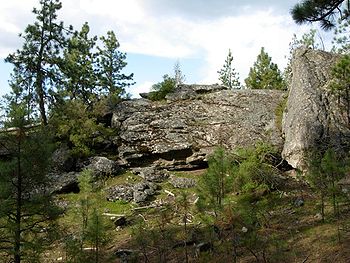
Dishman Hills
Encyclopedia

Washington Department of Natural Resources
The Washington Department of Natural Resources manage over of forest, range, agricultural, and commercial lands for the people of Washington State. DNR also manages of aquatic areas which include shorelines, tidelands, lands under Puget Sound and the coast, and navigable lakes and rivers...
) and non-profit (Dishman Hills Natural Area Association) groups, located in Spokane County, Washington
Spokane County, Washington
Spokane County is a county located in the U.S. state of Washington, named after the Spokane tribe. As of the 2010 census the population was 471,221, making it the fourth most populous county in Washington state. The largest city and county seat is Spokane, the second largest city in the state,...
. The granite outcroppings that form the bulk of the area were originally formed 70 million years ago, by volcanic magma pushing up through the Earth's crust, and then cooling. The current state of the rock was formed between 13,000 and 15,000 years ago by the Missoula Floods
Missoula Floods
The Missoula Floods refer to the cataclysmic floods that swept periodically across eastern Washington and down the Columbia River Gorge at the end of the last ice age. The glacial flood events have been researched since the 1920s...
. The hills consist of small ravines, ponds, and large chunks of granite, that support an eco-system consisting mainly of ponderosa pine, as well as about 300 different flowering plants (including Indian Camas
Camassia
Camassia is a genus of six species native to western North America, from southern British Columbia to northern California, and east to Utah, Wyoming and Montana...
), and 73 different species of mushrooms. The area also supports wildlife, such as coyote
Coyote
The coyote , also known as the American jackal or the prairie wolf, is a species of canine found throughout North and Central America, ranging from Panama in the south, north through Mexico, the United States and Canada...
s, marmot
Marmot
The marmots are a genus, Marmota, of squirrels. There are 14 species in this genus.Marmots are generally large ground squirrels. Those most often referred to as marmots tend to live in mountainous areas such as the Alps, northern Apennines, Eurasian steppes, Carpathians, Tatras, and Pyrenees in...
s, white-tailed deer
White-tailed Deer
The white-tailed deer , also known as the Virginia deer or simply as the whitetail, is a medium-sized deer native to the United States , Canada, Mexico, Central America, and South America as far south as Peru...
, pheasant
Pheasant
Pheasants refer to some members of the Phasianinae subfamily of Phasianidae in the order Galliformes.Pheasants are characterised by strong sexual dimorphism, males being highly ornate with bright colours and adornments such as wattles and long tails. Males are usually larger than females and have...
s, and dozens of species of butterflies
Butterfly
A butterfly is a mainly day-flying insect of the order Lepidoptera, which includes the butterflies and moths. Like other holometabolous insects, the butterfly's life cycle consists of four parts: egg, larva, pupa and adult. Most species are diurnal. Butterflies have large, often brightly coloured...
.
2008 Fire
On Thursday, July 10, 2008 at about 3:30 PM local time, the Valley View Fire started in the Dishman Hills area. As of Friday morning it burned 1200 acres (4.9 km²) and destroyed 11 homes. Washington State Governor Chris Gregoire declared a state of emergency for Spokane County. A mandatory evacuation was ordered in the area and two shelters were set up around Spokane Valley.A follow up story by the Spokesman Review on July 16, 2008 revealed that the fire's origin was a smoldering fire made by a resident on South Eastern Lane. The smoldering fire had been started days before the Dishman Hills Fire, and was left unattended inside of an old tree stump before it was whipped up by fierce winds on the afternoon of Thursday, July 11. These same winds spread the fire quickly across the Dishman Hills and threatened hundreds of homes along Dishman-Mica Road. Moreover, many homes in the Park Drive area (between the fire's origin and the Dishman Hills Natural Area) were in the direct path of the fire.
Among other things, some factors in the spread of the fire were the unprecedented wind speeds, and the amount of natural fuel in the Dishman Hills area (especially, fast burning ground fuels sprouted following Spokane's long winter).

